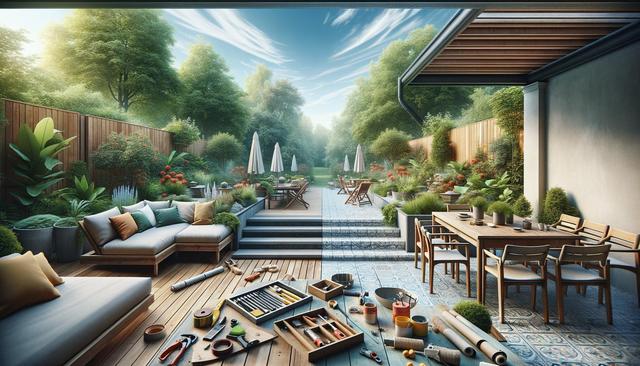Planning Your Patio Renovation
Before beginning any outdoor patio renovation, the planning phase is essential. This step helps determine your goals, budget, and the scope of the project. Start by identifying how you intend to use the space. Will it be primarily for relaxing, dining, entertaining guests, or perhaps a mix of all three? Knowing this will guide your choices in layout, materials, and features.
When setting your budget, it’s important to factor in not only materials and labor but also any permits or unexpected costs that might arise. Consult with a contractor or designer if you’re unsure where to begin. By planning carefully, you can avoid costly changes later in the process and ensure a smoother renovation experience.
Selecting the Right Materials
Choosing durable and weather-resistant materials is key to a long-lasting patio. Options range from natural stone and brick to concrete and composite decking. Each has its own aesthetic and maintenance requirements. For example:
- Natural stone offers a timeless look but may require sealing to protect it from the elements.
- Concrete can be stained or stamped for a custom appearance and is relatively low maintenance.
- Composite decking provides a wood-like finish with minimal upkeep, ideal for those seeking convenience.
Consider your climate when selecting materials. Areas with freeze-thaw cycles may benefit from flexible pavers or surfaces that resist cracking. Additionally, think about how the materials will integrate with the rest of your home’s exterior to maintain visual harmony.
Creating Functional Zones
To make the most of your patio renovation, divide the space into functional zones. This not only improves usability but also adds a sense of order and flow to your outdoor area. Common zones include:
- Dining area with a table and chairs, ideally located near the kitchen for convenience.
- Lounge area with comfortable seating and perhaps a fire pit or outdoor heater.
- Cooking zone featuring a grill, prep space, or even a full outdoor kitchen.
Use planters, furniture arrangement, or pergolas to define these zones. Lighting can also be used to create ambiance and highlight different areas. Thoughtful zoning ensures that each part of your patio serves a specific purpose while contributing to the overall functionality of the space.
Incorporating Greenery and Natural Elements
Adding plants and natural features can transform your patio into a more inviting and tranquil environment. Incorporate a mix of potted plants, flower beds, and vertical gardens to introduce color and life. Choose low-maintenance plants suited to your local climate for easier upkeep.
Consider installing a water feature like a small fountain or pond to enhance the calming atmosphere. Natural elements such as stone pathways, wooden accents, and gravel borders can also add texture and interest. These features not only beautify the patio but also create a closer connection to nature, making the space feel like an extension of the outdoors.
Enhancing Comfort and Usability
Maximizing comfort is crucial in any patio renovation. Comfortable seating, shade options, and weather protection ensure that the space is enjoyable throughout the year. Options to improve comfort include:
- Cushioned outdoor furniture for lounging and dining.
- Shade structures like umbrellas, pergolas, or retractable awnings.
- Heating elements such as fire pits or patio heaters for cooler evenings.
- Insect control solutions like screens or citronella plants.
Smart lighting and sound systems can also enhance the patio experience, allowing you to easily transition from daytime to evening use. With the right features, your patio can become a cozy and functional outdoor living area that adds value to your home and lifestyle.


